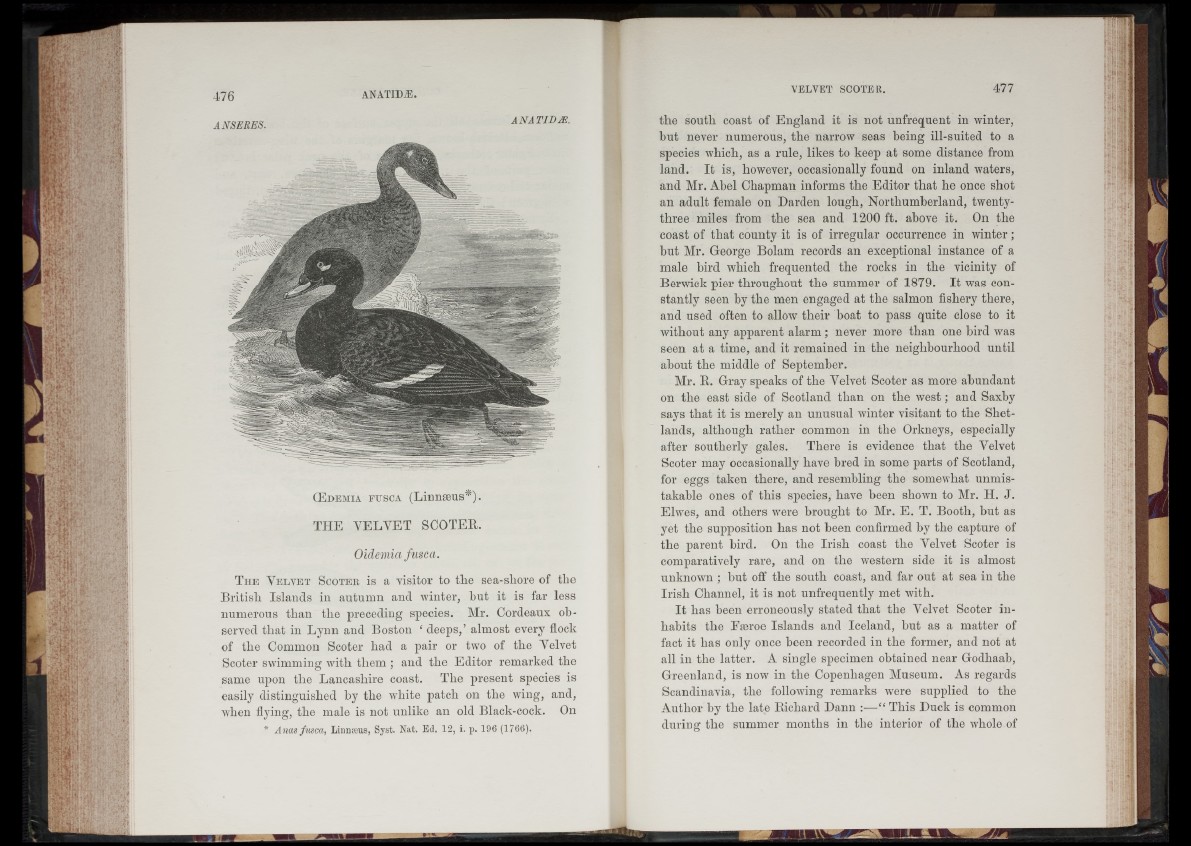
A NSERES. ANATID M.
QEd em ia fu sc a (Linnseus*).
THE VELVET SCOTER.
Oidemia fusca.
T h e V e l v e t S coteb is a visitor to the sea-shore of the
British Islands in autumn and winter, but it is far less
numerous than the preceding species. Mr. Cordeaux observed
that in Lynn and Boston £ deeps,’ almost every flock
of the Common Scoter had a pair or two of the Velvet
Scoter swimming with them ; and the Editor remarked the
same upon the Lancashire coast. The present species is
easily distinguished by the white patch on the wing, and,
when flying, the male is not unlike an old Black-cock. On
* Anas fusca, Lincreus, Syst. Nat. Ed. 12, i. p. 196 (1766).
the south coast of England it is not unfrequent in winter,
but never numerous, the narrow seas being ill-suited to a
species which, as a rule, likes to keep at some distance from
land. It is, however, occasionally found on inland waters,
and Mr. Abel Chapman informs the Editor that he once shot
an adult female on Darden lough, Northumberland, twenty-
three miles from the sea and 1200 ft. above it. On the
coast of that county it is of irregular occurrence in winter ;
but Mr. George Bolam records an exceptional instance of a
male bird which frequented the rocks in the vicinity of
Berwick pier throughout the summer of 1879. It was constantly
seen by the men engaged at the salmon fishery there,
and used often to allow their boat to pass quite close to it
without any apparent alarm; never more than one bird was
seen at a time, and it remained in the neighbourhood until
about the middle of September.
Mr. R. Gray speaks of the Velvet Scoter as more abundant
on the east side of Scotland than on the west; and Saxby
says that it is merely an unusual winter visitant to the Shet-
lands, although rather common in the Orkneys, especially
after southerly gales. There is evidence that the Velvet
Scoter may occasionally have bred in some parts of Scotland,
for eggs taken there, and resembling the somewhat unmistakable
ones of this species, have been shown to Mr. H. J.
Elwes, and others v'ere brought to Mr. E. T. Booth, but as
yet the supposition has not been confirmed by the capture of
the parent bird. On the Irish coast the Velvet Scoter is
comparatively rare, and on the western side it is almost
unknown ; but off the south coast, and far out at sea in the
Irish Channel, it is not unfrequently met with.
It has been erroneously stated that the Velvet Scoter inhabits
the Fteroe Islands and Iceland, but as a matter of
fact it has only once been recorded in the former, and not at
all in the latter. A single specimen obtained near Godhaab,
Greenland, is now in the Copenhagen Museum. As regards
Scandinavia, the following remarks were supplied to the
Author by the late Richard Dann :—“ This Duck is common
during the summer months in the interior of the whole of